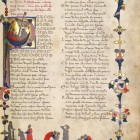The Trivulziano Codex 1080 and the text known as the ‘Danti del Cento’
The Trivulziano Codex 1080, a parchment volume copied in 1337 by Francesco di ser Nardo da Barberino in Florence, provides one of the most ancient and authoritative texts of Dante’s Divine Comedy followed by Chapters in terza rima by Iacopo Alighieri and Bosone Novello da Gubbio. The calligraphy is an elegant chancery-cursive script, accompanied by fine miniatures that have been attributed to the anonymous Master of the Dominican Effigies. In terms of graphic design and decoration the codex belongs to the group of the so-called ‘Danti del Cento’, while from a textual perspective the work is a primary example of Dante’s Comedy. This important manuscript probably found its way into the area under Venetian domination as early as 15th century, where it remained until it was acquired by Gian Giacomo Trivulzio at the time of the Napoleonic suppression of the region’s convents towards the beginning of the 1800s.
Leaf through the manuscript








